“Does anybody see a V.P. in that group? I don’t think so,” joked Donald Trump as he was speaking in Michigan before the Republican presidential debate. As far as Trump and many others are concerned, the contest for the Republican presidential nomination is already over and he can dismiss the entire GOP field as political nobodies. As his seven remaining Republican challengers gathered at the Ronald Reagan Library in Simi, California, Trump was near Detroit addressing auto workers in a non-union plant just one day after President Biden appeared on a picket line near Bellville, Michigan with unionized autoworkers, all members of the United Auto Workers (UAW). Inveighing against President Biden’s electric vehicle mandate, he proclaimed that in a Trump administration, gas vehicles will be allowed and sex change operations for minors will be banned.
It’s not hard to understand why the president and the former president made back-to-back appearances in Michigan. In 2016, Trump won Michigan by 11,000 votes on his way to a shocking upset victory over Hillary Clinton. In 2020, Biden took back the state by 154,000 votes, and union workers made a big difference. Biden got 62% of their vote in 2020, compared to just 53% for Clinton four years earlier.
The struggle between Democrats and Republicans over the working-class vote is a story that stretches back more than half a century. From the New Deal through the mid-1960s, these Americans formed the heart of the Democratic coalition, whose string of victories was interrupted only by a war hero, Dwight Eisenhower, who was courted by both parties. But after Lyndon B. Johnson’s landslide victory in 1964, discord over the Vietnam War, race, and the counterculture began to divide college educated and non-college Democrats. Unlike more upscale Democrats, white working-class voters supported the war, opposed the counterculture, and opposed racial integration when it seemed to threaten their neighborhoods, schools, and jobs.
Republicans exploited these divisions with robust appeals to patriotism and “traditional values” and by opposing affirmative action in hiring. After Ronald Reagan’s landslide victory over Walter Mondale in 1984, Democrats could no longer ignore their waning appeal to the white working class. In a study commissioned by the Michigan Democratic Party and financed primarily by the UAW, Stanley Greenberg, a public opinion expert and political analyst questioned focus groups in Macomb County, a working-class suburb of Detroit where Democratic voters had shifted extensively to the Republican column.
Greenberg’s findings triggered an intense debate among Democrats and led to efforts to elevate economic interests shared by white and Black voters over race-specific appeals. Bill Clinton rode this new strategy to victory over incumbent president George H. W. Bush in 1992 and an 8-point reelection victory in 1996, recovering a significant share of white working-class voters from the Republicans while retaining supermajorities of Black Americans.
For the next two decades, Republican candidates competed for white working-class voters predominantly with cultural appeals while retaining a pro-business economic agenda focused on tax and spending cuts—including reduced outlays for Social Security and Medicare. For their part, Democrats focused on economics, defending the large entitlement programs and charging that the Republicans’ plans for taxing and spending favored wealthy individuals and big business.
Trump’s insurgent 2016 campaign brushed aside the Reagan-Bush conservatism on his populist-style march to the Republican nomination. Trump claimed to be the only true defender of working-class interests and values, denouncing globalization, “unfair” trade deals, and China’s rise, which he argued had come at the expense of American workers. In the famous “down the escalator” speech announcing his candidacy, he insisted that Social Security, Medicare, and Medicaid needed to be saved without any cuts to beneficiaries. As president, Trump worked to retain his position as the working-class champion by drawing back from international economic institutions, pursuing a more protectionist strategy on trade, and denouncing Chinese exports as an assault on American workers. Democrats were thrown on the defensive, backing away from policies such as the Trans-Pacific Partnership that President Obama had advocated for.
The nomination of Joe Biden, who had long styled himself as the defender of the working class and of organized labor, represented the Democrats’ recognition of the changed landscape. Biden deemphasized trade treaties, pushed for “Buy American” policies in federal programs, and embraced an industrial strategy designed, as he often stated, to “create millions of high-paying union jobs right here in the USA.” This shift undergirded the increased working-class support that helped him accomplish in 2020 what Hillary Clinton could not in 2016.
This history set the stage for the clash between Biden and Trump in Michigan this week. More than a year before the general election, Trump and Biden have begun their campaign, with Biden aligning himself with the UAW leader’s attack on “corporate greed” and Trump proclaiming that Biden’s electric vehicle (EV) mandate would destroy autoworkers’ jobs and “assassinate” the U.S. automotive industry. EVs, Trump proclaimed, don’t travel far enough, cost too much, and are mostly made in China. He told the autoworkers that Biden is selling them out to the “radical environmentalists” and that their negotiations with the Big 3 automakers were meaningless if their leadership didn’t oppose the EV mandate. If the mandate persists, he predicted, their jobs will disappear and all the EVs will be made in China.
Rather than imposing mandates and regulations on our domestic auto production, Trump ticked off the accomplishments on trade during his presidency and promised what he termed “patriotic protectionism”—a new 10% across-the-board tariff—and what he termed “reciprocal tariffs” to match the barriers imposed by other countries. He offered a vision of American-made cars running on fossil fuels produced in America, a future in which American manufacturing is restored to what it was decades ago, where the gleaming factories and humming assembly lines are in the U.S. and the rusting factories are overseas.
While Trump was starting the general election, seven Republicans were on stage in California fighting for the Republican nomination. They didn’t seem to know that the race was over. Trump leads the Republican field in every poll, pulling off the amazing feat of increasing his lead even as an unprecedented number of indictments rolled in and his reputation as a brilliant businessman and his business itself was destroyed by a judge in New York.
So, what were those seven Republicans doing onstage?
Hoping for lightning to strike. If you read today’s polls, their collective stance sounds ridiculous, but the history of nomination races says not so fast. In a nomination race, one of the most dangerous positions to be in is “front-runner.” That’s because in the early stage of the nomination race, before many delegates are actually awarded, “winning” is defined by “winning” the expectations game and front-runners can run afoul of “expectations.”
A bit of history shows what could happen. In 1984, former Vice President Walter Mondale was running for the Democratic nomination. He was considered by most to be the front-runner and in the first contest, the Iowa caucuses, he garnered a substantial vote. It was so big, in fact, that the next day, the New York Times declared, “The magnitude of Mr. Mondale’s lead, however, also underscored predictions that no one would be able to stop him if he won a majority or near- majority victory over a crowded field.”
But what happened next is a warning to front-runners everywhere in every decade. The second-place candidate was a young, largely unknown U.S. Senator from Colorado, Gary Hart. He had no organization, no money, and no national name recognition save having been George McGovern’s campaign manager 12 years earlier. And yet it was Hart, not Mondale, who came out of Iowa like a shot and won the New Hampshire primary eight days later on the strength of momentum alone. And while he didn’t end up winning the nomination, he gave Mondale a run for his money all the way to the last primary.
So, what were all those candidates doing on stage? Trying to be Gary Hart or, in other words, trying to be the number two candidate who can go one-on-one with Trump. Nationally, Trump runs about 42 points ahead of the rest of the field, but in New Hampshire, he runs about 31% ahead of the rest of the field. In the early states, the voters are beginning to be engaged and tell pollsters they are open to alternatives.
The second Republican debate showed some signs of a nomination race that is maturing. The first sign is that they have figured out how to criticize Trump. With one solitary exception, it became clear that no one was going to touch Trump’s many indictments and the day’s ruling on fraud in his business empire with a 10-foot pole. However, they did criticize Trump’s record. The lead critic, former New Jersey Governor Chris Christie, said, “Trump, you’re afraid of being on this stage tonight, not because of the polls, not because of the indictments, but because you can’t defend your record.” Florida Governor Ron DeSantis accused Biden of being missing in action on the shutdown talks and then added, “You know who else is? Donald Trump. He should be here tonight.” And former South Carolina governor Nikki Haley accused Trump of being wrong on China, reciting a long list of policies that Trump did not focus on.
But with Trump not being present, they spent the bulk of their airtime attacking each other. It was clear that Haley wanted to send Vivek Ramaswamy to the corner—continually interrupting him and criticizing him for his dealings with China and TikTok. Senator Tim Scott (and former Vice President Mike Pence) rolled out some opposition research on Vivek Ramaswamy supposedly making money from business dealings in China. Pence attacked DeSantis for his spending in Florida, Haley attacked DeSantis for his energy policies and Scott for his lack of executive experience.
The two people who no one attacked were the Governor of North Dakota, Doug Burgum, and former Vice President Pence. Burgum kept trying to convince the audience that his experience as a business leader was key, but on the same day Trump was unveiled as more con artist than business leader, it was probably not the best time for that argument. Pence kept talking about his experience for the office, taking both of us back to 1984 when we worked for former Vice President Mondale. It didn’t work so well then, and it probably won’t work so well today. If no one criticizes you, it may be because they don’t think you’re a threat.
Debates don’t correlate exactly to votes, but they do give the voter a sense of how the candidates make their case. And, as the second Republican debate made clear, the battle for second place is on. We don’t know yet who may emerge as the alternative to Trump, although Haley is making a strong bid for that scenario. But last night’s debate showed that the GOP field understands that, for the time being, their real enemy is not Trump but one another, and the task over the next few months will be deciding who confronts Trump if the race becomes a one-on-one match against the former president. Whether that battle will center on Trump’s indictments, experience, or governing record will decide if there is a “Gary Hart” in this field or if Trump will romp untouched to the GOP nomination.
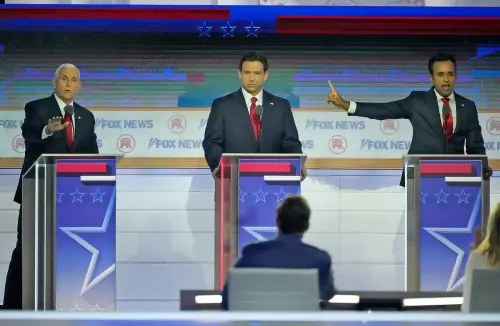
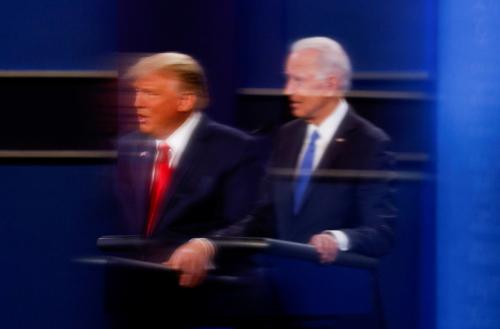
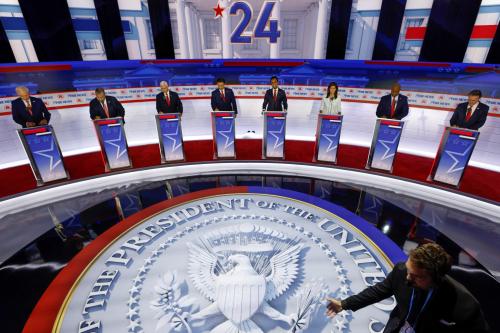
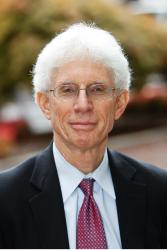



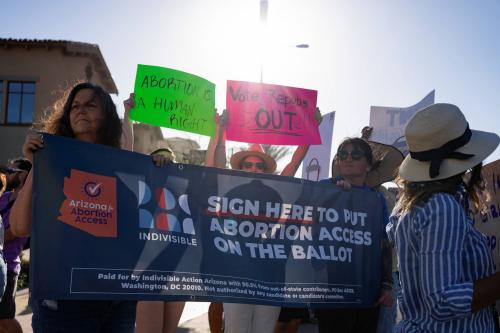
Commentary
Playing for second place in the Republican primary
September 28, 2023